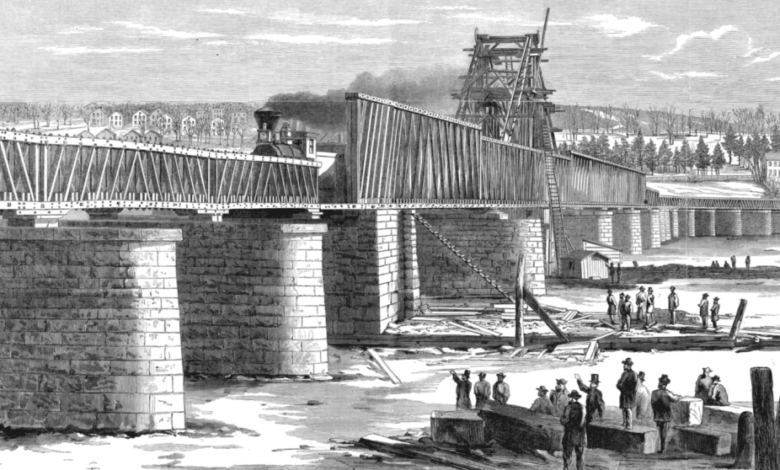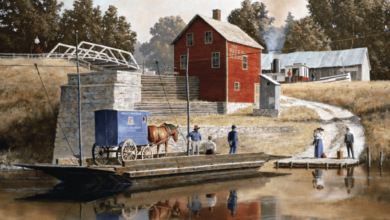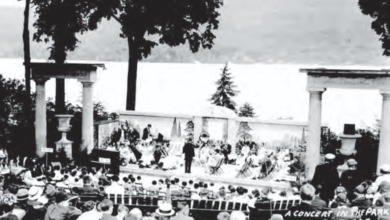Albany’s Livingston Avenue Railroad Bridge: Some History & Future Plans


 This article was original published in the July 6, 1867 Scientific American.
This article was original published in the July 6, 1867 Scientific American.
Our engraving [presented here] represents this structure [the Livingston Avenue Railroad Bridge in Albany] as it appeared in March, 1866, which was shortly after its completion.
Some years have elapsed since the first inauguration of the enterprise, which delay was occasioned by litigation on the part of Troy and other interests upon the river above Albany, but finally all obstacles were overcome, and the work on this bridge was commenced [at the end of the Civil War] in April, 1864.
The first locomotive, the Augustus Schell of the Hudson River Railroad, crossed the bridge Feb. 15, 1866, and the first passenger train on Feb. 22.
[Augustus Schell (1812 – 1884) was a director of several railroads including the Hudson River Railroad and was Chairman of the Democratic National Committee from 1872 to 1876.]The bridge proper (omitting the approaches, which in themselves are quite formidable) consists of two abutments and nineteen piers, making a total length of 2,020 feet. The extreme length of the bridge is nearly a mile.
The main channel of the river is crossed by four spans of 178 feet between the centers of the piers, on the plan known as “Howe’s” [using Howe Trusses] and and two draw spaces of 131 3/4 feet each.
The remaining 14 spans over the shallow water on the east side, as also over the basin on the Albany side, are short spans ranging from 75 to 78 feet each, built on the same general plan.
The trestle work approach to the bridge in the city is about 1,500 feet long.

 Our view represents the bridge from the Albany Basin to the eastern shore, as seen from the large New York Central Railroad [Grain] Elevator, which stands a few rods south of the bridge.
Our view represents the bridge from the Albany Basin to the eastern shore, as seen from the large New York Central Railroad [Grain] Elevator, which stands a few rods south of the bridge.
The drawbridge, including the iron turntable upon which it rests, is entirely novel, planned specially for the locality,
and the circumstances under which it has been built and will be operated.
The piers and abutments are all founded on piles. In some cases the bed of the river was excavated to a depth of ten or twelve feet, and within this space piles were driven to the hard bottom, sometimes as low as thirty-three feet.
A heavy timber crib was then built around these piles of the dimensions of the proposed pier, resting on the bottom of the excavation, and reaching to within three feet below water mark.
This crib was then filled with concrete and floored with heavy timber, upon which the first stones of the masonry were laid.
In other cases, after excavating as before, and driving the piles, the latter were sawed off, and a floating caisson, with a heavy timber floor, of the dimensions of the proposed pier, was anchored over the pile, and the masonry commenced in this caisson, which soon settled to its bearing on the heads of the piles, when the sides were removed by unscrewing some bolts, and floated away to serve else where.

 The piers are of cut limestone masonry, with rough faces, and are thirty feet in height above low water, and have a width at the bottom of nine feet, and at the top under the coping (which projects nine inches on all sides) of six and one half feet. They are all built of heavy cut stone laid in cement.
The piers are of cut limestone masonry, with rough faces, and are thirty feet in height above low water, and have a width at the bottom of nine feet, and at the top under the coping (which projects nine inches on all sides) of six and one half feet. They are all built of heavy cut stone laid in cement.
The face stones are all clamped together by iron clamps, and, in addition, the to faces of the pier are tied together by iron bars at intervals on each course along the front, extending through the pier from side to side ; and still further to insure the strength of the masonry, the head stones are all doweled together with iron dowels – each stone to the stones both above and below.
The bridge has been constructed by “The Albany Bridge Company,” constituted mainly of directors in the different railroads centering at Albany, and it is understood that it is owned one-half by the New York Central Railroad, and one quarter each by the Hudson River and Albany and Boston Roads.
The total cost of the bridge has been over a million of dollars.
Historical Addendum
At the time this first single track Hudson River Bridge was built, Livingston Avenue was known as Lumber Street, an important thoroughfare to Albany’s Lumber District.

 Cornelius Vanderbilt gained control of the Hudson River Railroad in 1864, shortly after his purchase of the parallel New York and Harlem Railroad.
Cornelius Vanderbilt gained control of the Hudson River Railroad in 1864, shortly after his purchase of the parallel New York and Harlem Railroad.
The winter after this bridge opened in 1866-1867 Vanderbilt refused to allow transfers from the New York Central and used the bridge as leverage in his acquisition of that railroad in 1867.
In 1869 he merged the New York Central with the Hudson River Railroad to form the New York Central and Hudson River Railroad, which from the city of New York to Albany, and then north to Troy by his leasing of the Troy and Greenbush Railroad.
After the Maiden Lane Bridge was completed to the south in 1871 this bridge was mostly utilized by freight or trains not stopping at Albany.
The current bridge was constructed in 1901-2 and was named the Livingston Avenue Bridge. It was built on the original 1866 pilings.
A new $634.8 million replacement bridge with two tracks was announced in July 2024. The new lift bridge would use only seven spans, though it would be taller and able to handle heavier loads. Completion of construction was planned for summer of 2028.
The Historical Addendum was added for the benefit of readers of the New York Almanack. You can read more about the politics surrounding the construction of this bridge here.
Illustrations: The full image and various details of “The Great Railroad Bridge Over The Hudson River At Albany,” Scientific American, July 6, 1867; and a photo of the bridge from the east end, ca. 2022 (DOT).
Source link




